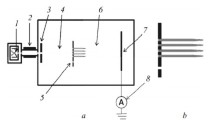Abstract
In this study, experiments are performed to study the transmission of 15 keV C− ions through straight and tapered borosilicate glass capillaries. The tilt angle is varied from 0° to 0.8°. In a straight capillary, the transmitted ions produced only one spot on the detector, and its intensity declined with increasing tilt angle. In this case, almost 98% of the transmitted particles maintained their initial charge. However, in the tapered capillary, the transmitted particles formed a different pattern composed of a core and a halo. The negative ion fractions of the core and the halo were 97.5% and 42.5% at a 0° tilt angle, respectively. Therefore, the particles formed the halo by scattering after colliding with the inner surface of the capillary, and most of them were neutralized. As the tilt angle increased, the intensity and negative ion fraction of the transmitted particles declined, and the halo gradually became quite asymmetric. These results indicate that the scattering process plays a role in the transmission.
Graphical abstract

Similar content being viewed by others
References
Y. Yamazaki, Nucl. Instrum. Methods Phys. Res. B 258, 139 (2007).
A.V. Krasheninnikov, F. Banhart, Nat. Mater. 6, 723 (2007).
M. Mehta, D. Reuter, A. Melnikov, A.D. Wieck, Appl. Phys. Lett. 91, 123108 (2007).
N. Stolterfoht, J.-H. Bremer, V. Hoffmann, R. Hellhammer, D. Fink, A. Petrov, B. Sulik, Phys. Rev. Lett. 88, 133201 (2002).
C. Lemell, J. Burgdörfer, F. Aumayr, Prog. Surf. Sci. 88, 237 (2013).
P. Skog, H.Q. Zhang, R. Schuch, Phys. Rev. Lett. 101, 223202 (2008).
N. Stolterfoht, R. Hellhammer, Z.D. Pešić, V. Hoffmann, J. Bundesmann, A. Petrov, D. Fink, B. Sulik, M. Shah, K. Dunn, J. Pedregosa, R.W. McCullough, Nucl. Instrum. Methods Phys. Res. B 225, 169 (2004).
N. Stolterfoht, R. Hellhammer, Z.D. Pešić, V. Hoffmann, J. Bundesmann, A. Petrov, D. Fink, B. Sulik, Surf. Coat. Technol. 196, 389 (2005).
N. Stolterfoht, Y. Yamazaki, Phy. Rep. 629, 1 (2016).
T. Nebiki, T. Yamamoto, T. Narusawa, M.B.H. Breese, E.J. Teo, F. Watt, J. Vac. Sci. Tech. A 21, 1671 (2003).
T. Ikeda, Y. Kanai, T.M. Kojima, Y. Iwai, T. Kambara, Y. Yamazaki, Appl. Phys. Lett. 89, 163502 (2006).
G. Sun, J. Wang, Y. Chen, J. Xu, C. Zhou, J. Shao, Y.C.B. Ding, Y. Yin, X. Wang, F. Lou, X. Lv, X. Qiu, J. Jia, L. Chen, F. Xi, Z. Chen, L. Li, Z. Liu, Phys. Rev. A 79, 052902 (2009).
L. Chen, X. Lv, J. Jia, M. Ji, P. Zhou, G. Sun, J. Wang, Y. Chen, F. Xi, Y. Cui, J. Shao, X. Qiu, Y. Guo, X. Chen, J. Phys. B 44, 045203 (2011).
H. Wang, L. Chen, X. Lv, C. Zhou, J. Jia, P. Zhou, J. Shao, M. Ji, X. Chen, Nucl. Instrum. Methods Phys. Res. B 286, 351 (2012).
L. Chen, Y. Guo, J. Jia, H. Zhang, Y. Cui, J. Shao, Y. Yin, X. Qiu, X. Lv, G. Sun, J. Wang, Y. Chen, F. Xi, X. Chen, Phys. Rev. A 84, 032901 (2011).
D. Feng, J. Shao, L. Zhao, M. Ji, X. Zou, G. Wang, Y. Ma, W. Zhou, H. Zhou, Y. Li, M. Zhou, X. Chen, Phys. Rev. A 85, 064901 (2012).
P. Pan, S.T. Niu, H.Y. Song, X.M. Chen, X.Y. Qiu, J.X. Shao, Nucl. Instrum. Methods Phys. Res. B 450, 327 (2019).
Q. Zhang, Z.L. Liu, P.F. Li, B. Jin, G.Y. Song, D.K. Jin, B. Niu, L. Wei, S. Ha, Y.M. Xie, Y. Ma, C.L. Wan, Y. Cui, P. Zhou, H.Q. Zhang, X.M. Chen, Phys. Rev. A 97, 042704 (2018).
J. Hasegawa, S. Jaiyen, C. Polee, N. Chankow, Y. Oguri, J. Appl. Phys. 110, 044913 (2011).
M.J. Simon, C.L. Zhou, M. Döbeli, A. Cassimi, I. Monnet, A. Méry, C. Grygiel, S. Guillous, T. Madi, A. Benyagoub, H. Lebius, A.M. Müller, H. Shiromaru, H.-A. Syn, Nucl. Instrum. Methods Phys. Res. B 330, 11 (2014).
H.Q. Zhang, N. Akram, R. Schuch, Phys. Rev. A 94, 032704 (2016).
A.X. Yang, B.H. Zhu, S.T. Niu, P. Pan, C.Z. Han, H.Y. Song, J.X. Shao, X.M. Chen, Phys. Rev. A 97, 052706 (2018).
Author information
Authors and Affiliations
Corresponding author
Rights and permissions
About this article
Cite this article
Song, H., Yang, Z., Yu, L. et al. Experiments of keV negative ions transmitted through straight and tapered glass capillaries: tilt angle dependence. Eur. Phys. J. D 74, 208 (2020). https://doi.org/10.1140/epjd/e2020-100615-7
Received:
Revised:
Accepted:
Published:
DOI: https://doi.org/10.1140/epjd/e2020-100615-7




